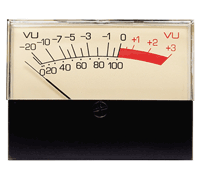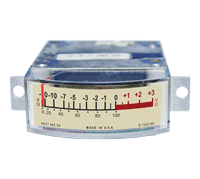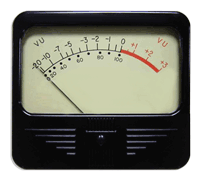Why sound engineers prefer Analog VU Meters
Published by Joe Legerstee

Why sound engineers prefer Analog VU Meters in recording studios?
Some things just don’t go out of style. Take blue jeans, for example.... Or consider the humble VU meter.
For recording engineers, it’s never gone out of style. Despite the digital revolution, analog VU meters are still quite popular in the recording studio amongst serious sound engineers. So, what’s the secret to their lasting appeal?
|
|
Analog VU (volume unit) meters measure sound as electrical signals in audio equipment. For all you engineers, VU meters are 200 μA DC d’Arsonval movement ammeters fed from a full wave copper-oxide rectifier. They measure average sound levels and are designed to represent the way human ears perceive volume, so that a reading of 0 VU (the “optimum audio level” or ideal constant voltage) represents +4 dBm, or 1.228 volts RMS across a 600-ohm load. The rise time of a VU meter (the time it takes to register the level of a sound) and the fall time (the time it takes to return to a lower reading) are both 300 milliseconds. |
|
|
John Maxwell Hobbs is the Head of Technology for BBC Scotland. He’s also a judge for the BBC Audio & Music Awards in the Best Sound category and a member of the BBC Introducing Listening Panel. In the studio, he’s recorded artists such as Bo Diddley, John Lee Hooker, and They Might Be Giants in the past. We asked Hobbs (via email) whether there were non-technical reasons recording engineers were so loyal toward analog VU meters: Is it something about visual feedback and multitasking? |
|
|
Still, their technical features offer no compelling argument as to why analog VU meters weren’t replaced long ago by their more-sophisticated digital cousins on recording consoles everywhere. To finally answer the question, we had to turn to a professional sound engineer. “You’ve provided the two key answers yourself!” he replied. “A third reason is familiarity. Engineers already understand what they mean.” “There is also the fact that by being a continuously variable indicator, they more accurately reflect what’s going on,” Hobbs added. “LED meters (and their onscreen analogs) are peak meters and are very glossy in their operation. A transient peak will always show up on a needle, not always on an LED meter.” So, there is a technical advantage! There you have it. |
Hoyt Meter have been the standard for high quality USA made precision Analog VU meters. We offer a wide range of Volume Unit Meters to meet your unique requirements for commercial, industrial and consumer using. If you would like to inquire about our line of High-quality VU Meters, please call one of our representatives at 800-258-3652.
More information:




